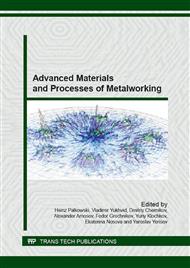[1]
Yu.I. Rybin, A.I. Rudskoy, A.M. Zolotov, Mathematical modelling and designing of metal forming processes, Nauka, Moscow, 2004. (in Russ. ).
Google Scholar
[2]
F. Dunne, N. Petrinic, Introduction to computational plasticity, Oxford University Press, Oxford, (2005).
Google Scholar
[3]
F.V. Grechnikov, Deformation of Anisotropic Materials: Intensification Reserves, Mashinostroenie, Moscow, 1998. (in Russ. ).
Google Scholar
[4]
V.V. Sokolovsky, Plasticity theory, Vysshaya Shkola, Moscow, 1969. (in Russ. ).
Google Scholar
[5]
D.Q. Wang, Numerical integration for anisotropic plasticity. Dissertation Thesis, Wyoming, (1995).
Google Scholar
[6]
J.D. Hambrecht, Elastic-plastic return algorithms for sheet metal forming simulations and spring back analysis. Dissertation Thesis, Ohio, (1993).
Google Scholar
[7]
R. Hill, Mathematical theory of plasticity, Oxford University Press, Oxford, (1998).
Google Scholar
[9]
F. Barlat, Constitutive modelling for metals, in: D. Banabic (Ed. ), Advanced methods in material forming, Springer, Berlin, 2007, pp.1-18.
Google Scholar
[10]
D. Banabic, S. Soare, About the mechanical data required to describe the anisotropy of thin sheets to correctly predict the earing of deep-drawn cups, International Journal of Material Forming. 1 (2008) 285-288.
DOI: 10.1007/s12289-008-0348-x
Google Scholar
[11]
J. Majak, S. Toompalu, M. Pohlak, Material parameters identification by use of hybrid GA, Journal of Achievements in Materials and Manufacturing Engineering. 27 (2008) 63-66.
Google Scholar
[12]
Yu.M. Aryshensky, F.V. Grechnikov, Theory and calculation of plastic forming of anisotropic materials, Metallurgiya, Moscow, 1990. (in Russ. ).
Google Scholar
[13]
Yu.M. Aryshensky, Theory of sheet metal forming of anisotropic materials, Saratov University, Saratov, 1973. (in Russ. ).
Google Scholar
[14]
M.V. Storozhev, E.A. Popov, Metal forming theory, Mashinostroyeniye, Moscow, 1977. (in Russ. ).
Google Scholar
[15]
D.D. Ivlev, G.I. Bykovtsev, Theory of plastic work-hardening body, Nauka, Moscow, 1971. (in Russ. ).
Google Scholar
[16]
E.S. Neto, D. Peric, D.R.J. Owen, Computational methods for plasticity: theory and applications, John Wiley & Sons Ltd, London, (2008).
Google Scholar
[17]
D.R.J. Owen, E. Hinton, Finite elements in plasticity: theory and practice, Pineridge Press Limited, London, (1980).
Google Scholar
[18]
E.A. Volkov, Numerical methods, Nauka, Moscow, 1987. (in Russ. ).
Google Scholar


